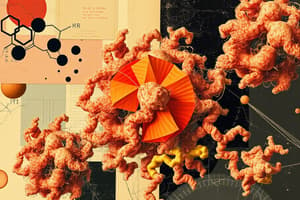Podcast
Questions and Answers
How does the tertiary structure of a protein differ from its secondary structure?
How does the tertiary structure of a protein differ from its secondary structure?
The tertiary structure is a combination of secondary structures and is primarily determined by the chemical interactions between side chains of amino acids.
What factors contribute to the final shape of a protein's tertiary structure?
What factors contribute to the final shape of a protein's tertiary structure?
The final shape is determined by the primary structure of the protein and influenced by environmental factors that affect amino acid interactions.
Define a dimer and explain how it is formed at the quaternary structure level.
Define a dimer and explain how it is formed at the quaternary structure level.
A dimer is a complex formed when two identical polypeptide chains bind together through interactions at their binding sites.
What are the distinguishing features of a #-mer in the context of protein quaternary structure?
What are the distinguishing features of a #-mer in the context of protein quaternary structure?
Why can there be more possible tertiary structures for proteins than there are secondary structures?
Why can there be more possible tertiary structures for proteins than there are secondary structures?
What distinguishes essential amino acids from non-proteinogenic amino acids?
What distinguishes essential amino acids from non-proteinogenic amino acids?
How does the incorporation of selenocysteine differ from typical amino acids during translation?
How does the incorporation of selenocysteine differ from typical amino acids during translation?
What role does pyrrolysine play in some methanogenic Archaeans and how is it coded?
What role does pyrrolysine play in some methanogenic Archaeans and how is it coded?
Describe the significance of the ambiguous stop codons in the context of amino acid incorporation.
Describe the significance of the ambiguous stop codons in the context of amino acid incorporation.
What are the three main steps in the translation process and how do they function?
What are the three main steps in the translation process and how do they function?
Flashcards are hidden until you start studying
Study Notes
Protein Structure
- Tertiary structure is a combination of secondary structures, determined by interactions between amino acid side chains.
- Primary sequence influences the final shape, but the environment plays a significant role in defining tertiary structure.
- There is a greater diversity of possible tertiary structures than secondary structures for proteins of equal size, allowing for extensive variability in shape and function.
Quaternary Structure
- Quaternary structure involves the interaction of multiple polypeptide chains to form complexes (e.g., dimers, trimers, and tetramers).
- Specific binding sites facilitate the recognition and binding between proteins, forming larger symmetric complexes.
- Naming conventions for polypeptide assemblies include terms like dimer (identical chains) and heterodimer (different chains); assemblies of 21 or more are referred to as #-mers (e.g., 52-mer).
- Typical quaternary structures range from 2 to 8 chains, though some viruses may have capsids with multiples of 60 units.
Essential Amino Acids
- Essential amino acids for eukaryotes include histidine, isoleucine, leucine, lysine, methionine, phenylalanine, threonine, tryptophan, and valine (H, I, L, K, M, F, T, W, V).
- Non-proteinogenic amino acids are not used to make proteins, such as GABA or L-DOPA.
- Unusual amino acids can arise from expansions in the genetic code, such as selenocysteine and pyrrolysine.
Special Amino Acids
- Selenocysteine is incorporated in the presence of selenium; coded by UGA which typically serves as a stop codon.
- Pyrrolysine occurs in some methanogenic Archaea, coded by UAG, also a stop codon under normal conditions.
Translation Steps
- Translation consists of initiation (binding of ribosome and mRNA), elongation (tRNAs add amino acids), termination (ribosome meets stop codon), and processing (addition of functional groups).
- Processing modifications, such as glycosylation, affect protein function, exemplified by the HbA1C test that measures glycosylated hemoglobin.
Polysomes and Translation Speed
- Polysomes consist of multiple ribosomes translating a single mRNA, enabling rapid protein synthesis.
- Ribosomes are typically spaced 35 nucleotides apart, creating a left-handed helical structure in eukaryotes.
- Polysomes allow proteins to be generated faster than sequencing them one at a time.
Ribosomal Structure and History
- Prokaryotic ribosomes comprise 50S and 30S subunits (70S total), while eukaryotic ribosomes have 60S and 40S subunits (80S total)—though the total does not correlate with their actual size.
- Ribosome isolation uses ultracentrifugation, a technique developed by Theodor Svedberg, who won the Nobel Prize in 1926 for his work in colloidal chemistry.
Clinical Applications of Tetracycline
- Ancient Nubian mummies exhibited fluorescent bands in bones due to tetracycline from contaminated grains used in beer and bread.
- Tetracycline serves as a valuable tool for studying bone growth, as the distance between fluorescent lines indicates bone apposition over time.
Studying That Suits You
Use AI to generate personalized quizzes and flashcards to suit your learning preferences.





